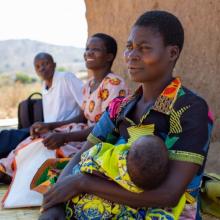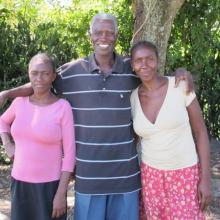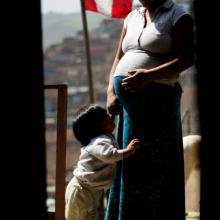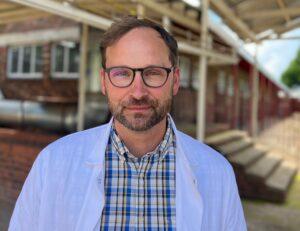
Normally based in Saskatoon, PIH Canada Board member Dr. Ryan Meili is a family physician and lifelong advocate for healthy public policy with a focus on health equity. In the article series “A View from Lesotho,” Dr. Meili will be sharing his thoughts and experiences from Lesotho, where he is currently serving as a clinical volunteer with Partners In Health, based in Maseru at Botšabelo Hospital, along with his wife Mahli, a pediatrician.
Courtesy of Ryan Meili
Wasting Away
Ntate* is so thin, all collarbones and orbits, that we don’t need a stethoscope to examine his heart. You can see the beats between his ribs. He looks the image of starvation in some drought-stricken region of the world, but his famine is internal, illness draining him from within. He is our sickest patient at Botšabelo, and each day we visit him on rounds, trying to figure out how to fight back against what’s making causing him to waste away. The trouble is, it’s not just one thing. HIV and drug-resistant TB have teamed up with other opportunistic infections to take aim at this young man’s life.
Lesotho’s lowest point is over 1400 metres above sea level, making it the only country that is entirely above 1000 meters, earning this tiny constitutional monarchy the nickname “Kingdom of the Sky”. Less majestically, the country also has sky high rates of tuberculosis, the highest per capita in the world, and is second only to Africa’s other tiny, landlocked kingdom, Eswatini (formerly Swaziland) in prevalence of HIV/AIDS.
2020 was the year the word pandemic entered the lexicon in an entirely new way, finding its way into nearly every newscast and conversation as COVID-19 infected all aspects of our lives. Given its respiratory nature, wide and immediate spread, and the coincidence of a century between them, the historical pandemic most often invoked was the Great Influenza of 1918-2020. There were, however, two other pandemics already underway that had been taking lives for, respectively, decades and centuries: HIV and TB.
I was first exposed to these pandemics as a medical student. To TB, that exposure was literal, I picked up latent tuberculosis while spending the summer volunteering and learning in Calcutta and Chennai. Fortunately, I’m one of the lucky ones, having never had any symptoms or risk of spreading it to others. As for HIV, I first visited Massinga in rural Mozambique twenty years ago at the peak of the pre-antiretroviral era of AIDS in Africa. I would return several times over the coming years, deeply grateful to witness a sea change. That change came more slowly than it should have due to resistance from western governments and the pharmaceutical lobby, but thanks to the tireless advocacy of many – including the pioneering work of Paul Farmer and Partners In Health treating HIV in rural Haiti – it did come.
Within a few short years we went from having nothing to offer families collecting their loved ones from the Massinga Health Centre to go die in the village to seeing patients on treatment and on track for normal lives. Things have come so far that a colleague I spoke to the other day here in Lesotho complained about how boring he finds HIV care: people just take the same meds every day and they’re fine, there’s nothing to do. How glorious. May you always be boring to doctors!
Sadly, not everyone is so dull, and it’s thanks to a less common but even more powerful word than pandemic: syndemic. Defined as “the convergence of two or more diseases that act synergistically to magnify the burden of disease,” the calling card of a syndemic is that the illnesses involved team up to make life worse not only for the patient but for society as a whole. The twin pandemics of TB and HIV are trouble enough on their own, but as a deadly human syndemic they cause incredible damage to patients and communities.
For the patient, having HIV puts you at greater risk for TB illness. HIV reduces the CD4 cells that fight infection, making people with HIV far more likely to get sick with a primary TB or reinfection on subsequent exposure. When people whose immune system is damaged catch TB, it progresses more quickly to serious lung disease or extrapulmonary (outside the lungs) manifestations like meningitis or bone infections.
The other way HIV puts you at risk is that a weakened immune system can result in awakened TB. Most people who are exposed to TB are able to fight it off so that they don’t get sick, but our bodies have a very hard time killing the bug (mycobacterium tuberculosis) entirely. Instead we end up with latent or “sleeping” TB. Healthy people then have a 5-10% lifetime chance of becoming sick with TB somewhere down the road. With untreated HIV, that risk increase to 3-16% per year. Treatment of HIV with anti-retrovirals can also wake up the immune system, causing it to overreact to unaddressed opportunistic infections, a phenomenon called Immune Reconstitution Inflammatory Syndrome (IRIS).
This symbiotic syndemic relationship works in the other direction as well. Being infected with TB increases the activity of HIV, with higher viral loads resulting in more immune suppression and faster progression to AIDS. This also contributes to the community effect. Higher viral loads means more risk of transmitting HIV. Quicker progression to bad disease and a longer infectious period means more coughing and more sharing of TB. The virus and the bacteria team up to increase the risk for everyone.
In Lesotho, we see that effect in action as the rates of co-infection are extremely high. The country leads the world in per capita TB infections and 59% of those TB patients are co-infected with HIV. For Multi-Drug Resistant (MDR)-TB patients like the ones we see at Botšabelo that number goes up to 73%. This means the patients with the trickiest bugs to treat are faced with the added burden of an immune system that’s under attack, and a health system that’s overwhelmed. As PIH colleagues Dr. Afom Andom et al. describe in this Global Public Health Article, multiple barriers to screening result in only half of the TB cases ever being diagnosed. A tremendous amount of work has gone into getting TB under control in the country, but realities of poverty, geography, health literacy and limited resources make this a daunting challenge.
The good news in this challenging situation comes in the form of incredible advancements in HIV care and the resultant drop in cases worldwide. The rates of new cases have dropped by 38% in the last decade, and by a whopping 57% in Southern and Eastern Africa. In 2022 630,000 people died from HIV worldwide. This is still far too many, of course, but it’s incredible progress from the over 2 million deaths at the 2004 height of the HIV. That successful fight against HIV must continue and it must be accompanied by added efforts to root out its partner in crime, as a third of HIV deaths in 2022 were caused by tuberculosis. An estimated quarter of the world’s population is infected with tuberculosis, and it continues to kill more people per year than any other infectious disease (with the exception of the peak years of the COVID-19 pandemic), over 1.5 million in 2021.
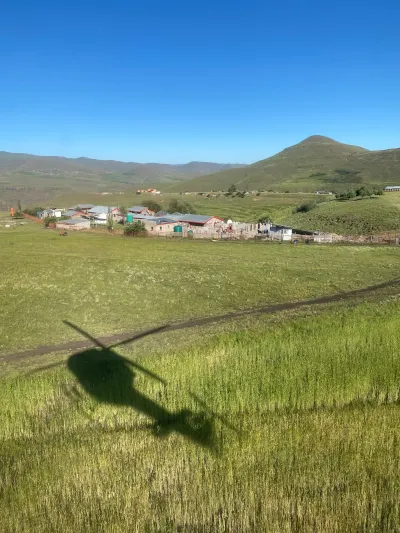
Helicopter landing at the remote PIH primary care site of Bobete.
Mahli Brindamour / Partners In Health Canada
Expanding the success of the fight against HIV/AIDS means moving beyond silos and vertical programs and creating systems that can respond to TB and other infections, as well as non-communicable disease (NCDs) like hypertension, diabetes and heart disease. This is part of what impresses and inspires me about Partners in Health in Lesotho. Along with the specialized work of managing MDR-TB care for the country, PIH Lesotho’s Rural Initiative provides primary care at several sites in the hardest to reach remote mountainous regions of the country (two of which Mahli visited by Lesotho Defence Forces helicopter this past week). This approach deals with the big bad guys of the TB-HIV syndemic without neglecting the integrated care of the whole patient and their community.
It’s that same approach that is helping Ntate to get better. It would have been easy to see a patient that sick as beyond our help, to say we should focus our efforts on those with better prospects for recovery. Thankfully, that’s not the PIH philosophy, and the attentive, thorough and compassionate team refused to walk away. They made a monumental effort to understand why he was wasting away.
They carefully monitored his feeds and his labs. They moved mountains to get medications. He’s now slowly getting stronger, even able to walk with support. His road ahead is not going to be an easy one, he’s a long way from his former self, but there is a road.
If we can give the same care and attention to the challenges in the world’s poorest places as clinical staff here give to the sickest people, there is hope to break the syndemic cycle.
*(Not his name. Ntate is the Sesotho word for father, but depending on intonation can mean anything from “pardon me sir?” to “put ‘er there, bro!

